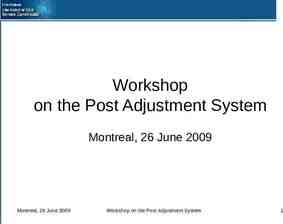Introduction to CMMI® CMMI-SE/SW/IPPD/SS, Version 1.1
26 Slides464.00 KB
Introduction to CMMI CMMI-SE/SW/IPPD/SS, Version 1.1 Staged Representation 課程介紹 程式設計組 邱淑美 台大計算機及資訊網路中心
CMMI (Capability Maturity Model Integration) 能力成熟度模式整合 – SW-CMM Capability Maturity Model for Software – SE-CMM Systems Engineering Capability Maturity Model – IPD-CMM Integrated Product Development Capability Maturity Model – CMMI-SE/SW Version 1.1 – CMMI-SE/SW/IPPD Version 1.1 – CMMI-SE/SW/IPPD/SS Version 1.1 – CMMI-SW Version 1.1 美國軟體工程學院 ( SEI , The Software Engineering Institute) 提供流程改善之完善架構與評鑑標準
CMMI Models 專業領域 (disciplines) – Systems Software engineering – Systems Software engineering Integrated product and Process Development (IPPD) – Systems Software engineering IPPD Supplier Sourcing – Software engineering
CMMI Models 表述 (Representation) options – 分段式 (Staged) organizational maturity 5 Maturity levels Permit comparisons across and among organizations – 連續式 (Continuous) Process area capability 5 Capability levels provide a recommended order for approaching process improvement within each process area.
2 Presentations
成熟度 (Level 1 – Level 5) in Staged Representation
能力度 (The Capability Levels) in Continuous Representation
The Maturity Levels in Staged Representation 1. Initial 2. Managed 3. Defined 4. Quantitatively Managed 5. Optimizing
Maturity Level 1: Initial Chaotic. Competence and heroics Not repeatable
Structure of CMMI Staged Representation
Maturity Level 2: Managed 流程領域 (Process Area) for level 2 – 需求管理 (Requirements Management) – 專案規劃 (Project Planning) – 專案監控 (Project Monitoring and Control) – 供應商協議管理 (Supplier Agreement Management) – 度量與分析 (Measurement and Analysis) – 流程與產品品質保證 (Process and Product Quality Assurance) – 建構管理 (Configuration Management)
Maturity Level 3: Defined 流程領域 (Process Area) for level 3 – 需求發展 (Requirements Development ) – 技術解決方案 (Technical Solution ) – 產品整合 (Product Integration ) – 驗證 (Verification) – 確認 (Validation ) – 組織流程專注 (Organizational Process Focus ) – 組織流程定義 (Organizational Process Definition ) – 組織訓練 (Organizational Training ) – 整合的專案管理 (Integrated Project Management for IPPD ) – 風險管理 (Risk Management ) – 整合團隊管理 (Integrated Teaming ) – 整合供應商管理 (Integrated Supplier Management ) – 決策分析與解決方案 (Decision Analysis and Resolution ) – 適於整合之組織環境 (Organizational Environment for Integration)
Maturity Level 4: Quantitatively Managed 流程領域 (Process Area) for level 4 – 組織流程績效 (Organizational Process Performance) – 數量化專案管理 (Quantitative Project Management)
Maturity Level 5: Optimizing 流程領域 (Process Area) for level 5 – 組織創新與推展 (Organizational Innovation and Deployment) – 原因分析與解決方案 (Causal Analysis and Resolution)
Structure of CMMI Staged Representation
PA, SG, SP, GG, GP PA (Process Area): Requirement management SG (Specific Goal): requirements maintained and accurately reflected in project plan, activities and product SP (Specific Practice): maintain the traceability to their source requirements GG (Generic Goal): Institutionalize a managed process GP (Generic Practice): Establish a organizational policy
Example: PA: REQM Specific and Generic Goals SG 1 Manage Requirements SP 1.1 Obtain an Understanding of Requirements SP 1.2 Obtain Commitment to Requirements SP 1.3 Manage Requirements Changes GG 2 Institutionalize a Managed Process The process is institutionalized as a managed process.
Example: PA: REQM GG 2 Institutionalize a Managed Process Commitment to Perform – GP 2.1 (CO 1) Establish an Organizational Policy Ability to Perform – GP 2.2 (AB 1) Plan the Process – GP 2.3 (AB 2) Provide Resources – GP 2.4 (AB 3) Assign Responsibility – GP 2.5 (AB 4) Train People
Example: PA: REQM GG 2 Institutionalize a Managed Process Directing Implementation – GP 2.6 (DI 1) Manage Configurations – GP 2.7 (DI 2) Identify and Involve Relevant Stakeholders – GP 2.8 (DI 3) Monitor and Control the Process Verifying Implementation – GP 2.9 (VE 1) Objectively Evaluate Adherence – GP 2.10 (VE 2) Review Status with Higher Level Management
行動步驟 成立推動小組 決定模式 建立標準 教育訓練與執行 稽核
軟體發展模式 1. 軟體發展計畫 2. 軟體需求規格 3. 軟體設計規格 4. 資料 / 程式對照清單 5. 驗收測試計畫 6. 軟體測試報告 7. 軟體使用手冊 8. 系統使用說明會 9. 系統發展過程記錄
益處 引進 CMMI 模式之後 – Productivity and Quality – 制度化、透明化 – 職務異動影響小 – 避免工作重複 – 避免錯誤再犯 – 人盡其才
實務範例: Team work Product Manager Project Manager Software Engineer, Developers DBA, IT Quality Assurance Engineer Technical Document Engineer
實務範例: Documentation Product Requirement Doc, PRD Project plan, Road map Design Doc Test plan Schedules Acceptance Criteria
施行 CMMI 可能面臨的課題 人力資源的配置 時程的壓力 文化的改變所帶來的抗拒 標準的制訂 稽核的落實
總結 CMMI 的歷史 流程改善的模式與架構 模式術語 (Model Terminology) 達成 CMMI 各成熟度應提出的證據 流程改善後之獲益































